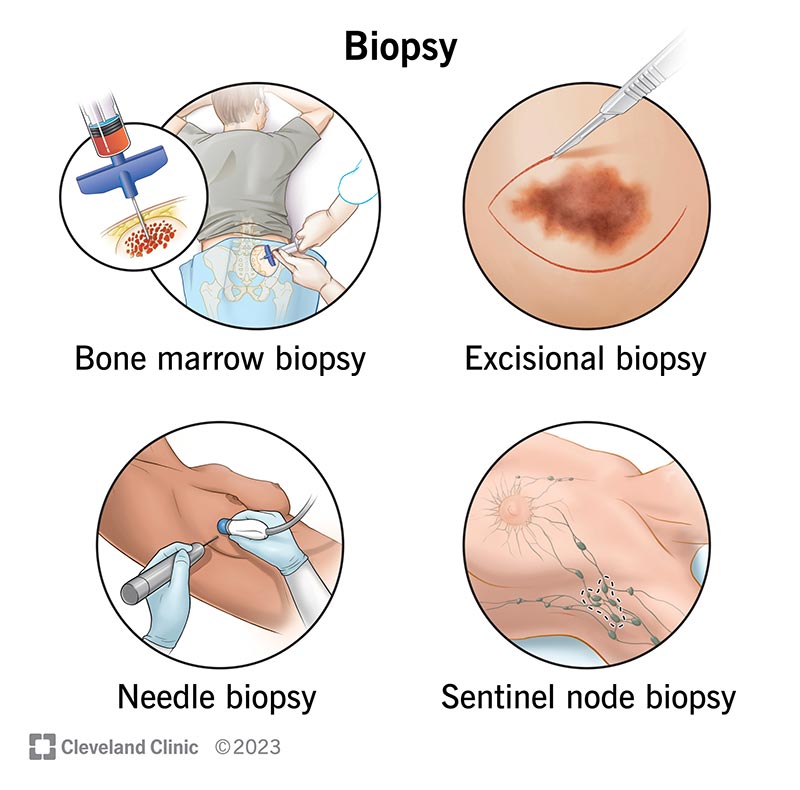A biopsy is a procedure to remove cells, tissue or fluid for examination by a medical pathologist. Healthcare providers do biopsies when they identify areas of concern or if you have symptoms or signs of certain conditions. There are different types of biopsy procedures.
Advertisement
Cleveland Clinic is a non-profit academic medical center. Advertising on our site helps support our mission. We do not endorse non-Cleveland Clinic products or services. Policy

A biopsy is one of the ways healthcare providers determine what’s going on in your body. In a biopsy, a provider removes samples of your tissue, cells or fluids so a medical pathologist can examine them for signs of disease. Providers may recommend biopsies to diagnose or monitor medical conditions or to plan treatment.
Advertisement
Cleveland Clinic is a non-profit academic medical center. Advertising on our site helps support our mission. We do not endorse non-Cleveland Clinic products or services. Policy
You may hear the term “biopsy” and think “cancer,” but providers do biopsies to diagnose many medical conditions, like:
All biopsies are procedures to obtain samples of tissue and fluid, but they’re done in different ways. Healthcare providers may do biopsies in medical offices or operating rooms. Biopsy types include:
Advertisement
Your healthcare provider understands why you may be anxious about having a biopsy. They’ll take time to explain the procedure they’ll use, including whether you’ll be awake or under anesthesia. They’ll also review the following information so they know:
Your provider will also let you know if you’ll need to:
Finally, your provider will explain what kind of anesthesia they’ll use so you don’t experience pain during the procedure:
There are different ways to do biopsies. The kind of biopsy you’ll have depends on the location of the tissue or fluid your provider wants to examine. Some common biopsies are:
That depends on the anesthesia used and if there were complications. In general, people who received local anesthesia can go home after the procedure. People who had general anesthesia typically have an overnight hospital stay.
If you receive anesthesia, the procedures shouldn’t hurt. You may have some post-procedure pain. If you do, let your provider know. They’ll recommend pain medication.
Biopsy complications are rare, but they can happen. Depending on the biopsy procedure, complications may include:
Contact your provider if:
Advertisement
Waiting for results may be the hardest part of having a biopsy. Your healthcare provider will explain how and when you’ll receive results. Biopsy results may be available within a few hours, a few days or more than a week. Follow up with your provider if you haven’t received the results when you expected.
Your healthcare provider will explain test results that detect issues, such as cells that don’t look like normal cells. They’ll also explain the next steps, whether that’s additional tests or planning treatment.
Biopsies are a very accurate way to detect abnormal cells or other changes in your body that may be signs of issues. That said, studies suggest false-negative results do happen. A false-negative result means you have cancer or another illness that a biopsy didn’t detect. False-negative rates vary depending on the type of cancer or medical condition. If you’re having a biopsy, ask your provider about false-negative rates for that type of biopsy.
A biopsy is a procedure to remove cells, tissue or fluid for examination by a medical pathologist. They can be stressful. It’s stressful to learn you need one, stressful to go through one and especially stressful while you await results. Your healthcare provider understands all the ways a biopsy may affect you, so don’t hesitate to ask questions.
Advertisement
If you’re having a biopsy, try to remember a biopsy is a test to detect any issues. It doesn’t mean you have cancer or another serious illness. And if your biopsy results show something is going on, try to think of the results as your first step toward getting well. Your provider will help you every step of the way to stay informed and help you make important decisions about your health.
Advertisement
Cleveland Clinic’s primary care providers offer lifelong medical care. From sinus infections and high blood pressure to preventive screening, we’re here for you.

Last reviewed on 05/26/2023.
Learn more about the Health Library and our editorial process.